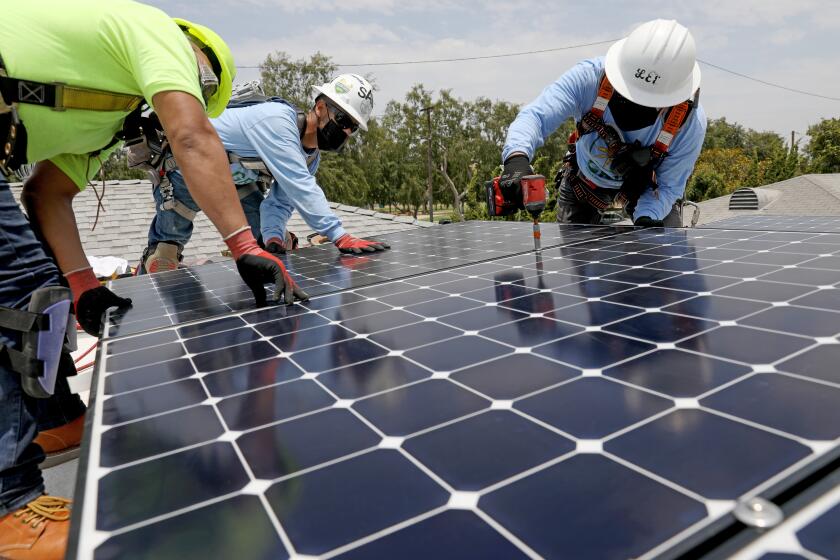California slashed rooftop solar payments. Now opponents want a rehearing

Environmental groups say the new rules for compensating solar customers would undermine growth of rooftop solar.
- Share via
A trio of environmental groups wants the California Public Utilities Commission to upend last month’s decision that overhauled the rules for Californians who install rooftop solar on their homes and businesses, reducing payments to new solar customers for the electricity they generate.
The Protect Our Communities Foundation, the Environmental Working Group and the Center for Biological Diversity filed an application for a rehearing and a reversal of the Dec. 15 ruling by the commission.
“They made a mistake,” said Bill Powers, an engineer and board member of the Protect Our Communities Foundation. “This was the wrong decision.”
At issue is what’s colloquially called NEM 3.0 — the third iteration of Net Energy Metering rules in California that determine the size of the credits customers receive on their utility bills when their rooftop solar systems generate more energy than they consume. Critics of the old rules said they resulted in higher electric bills for households without rooftop solar panels, including low-income families that can’t afford them.
Passed with all five commissioners voting in favor, the complicated 260-page decision also will include $900 million in upfront incentives for customers to pair solar with battery storage systems, with $630 million set aside for low-income customers. The commission estimates the updated rules will save average residential customers with solar-plus-storage at least $136 a month on their utility bills.
One of the key provisions alters the way rooftop solar owners are compensated for the excess electricity their systems send back to the grid.
Gov. Gavin Newsom’s appointees voted unanimously to reduce payments to homes and businesses that go solar.
Instead of being credited at the retail rate of electricity, customers will get paid at the “actual avoided cost.” That figure is lower than the retail rate during the daylight hours when solar energy is abundant and cheap, but it’s higher during the evening hours — when solar production ramps down to practically zero when the sun goes down and California’s electric grid is under the most stress.
The California Solar & Storage Assn., which vehemently opposed the rule changes, has estimated the average compensation rate would drop from 30 cents per kilowatt-hour to 8 cents, a reduction of 75%.
The updated solar rules are scheduled to go into effect in mid-April and will affect new solar customers.
The request for a rehearing zeroes in on a state law that became part of the Public Utilities Code. A section of the code instructs the commission to ensure “that customer-sited renewable distributed generation continues to grow sustainably and include specific alternatives designed for growth among residential customers in disadvantaged communities.”
The groups’ filing argues NEM 3.0 as written “fails to comply” with that mandate.
Want to go solar, and maybe add a battery? Here’s what you need to know.
Installing rooftop solar can run into the tens of thousands of dollars, and the groups say the new rules will extend the system’s payback period, discouraging customers from investing in solar, and decrease the savings customers receive on their utility bills.
Therefore, they say, the decision “will devastate solar adoption rates and thus fail to ensure the continued sustainable growth of distributed generation.”
On the day the new rules were adopted, CPUC Commissioner John Reynolds predicted the changes will not undermine solar’s growth in California. When the rules were last updated in 2016, Reynolds said, there was a decline in the number of solar systems connected to the utility grid but the numbers rebounded and reached record highs in 2022.
“All of this is to say there will be some measure of decrease after this decision that is absolutely to be expected,” Reynolds said, “but it will not signal the death of the industry or the rooftop solar market.”
The commission also received one other application for a rehearing — from Michael E. Boyd, president of Californians for Renewable Energy, a nonprofit in Santa Cruz County.
Replacing agriculture with solar panels could help solve the West’s energy and water crises. But farmers are fighting back.
As for what happens next, CPUC spokeswoman Terrie Prosper said in an email that although the commission will issue a formal decision regarding the applications for a rehearing, “there is no specific timeline” as to when that decision will be issued.
Powers of the Protect Our Communities Foundation said he is not optimistic that the commission will reverse its decision but cited a procedural requirement called “exhaustion of administrative remedies” that mandates that challengers pursue all available administrative avenues and raise all issues before bringing a lawsuit against a public agency.
“So if we don’t file the application for a rehearing, there is no possibility of taking this to an appellate court,” Powers said.
More to Read
Inside the business of entertainment
The Wide Shot brings you news, analysis and insights on everything from streaming wars to production — and what it all means for the future.
You may occasionally receive promotional content from the Los Angeles Times.














